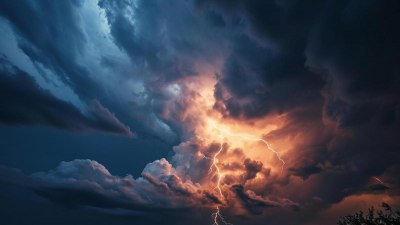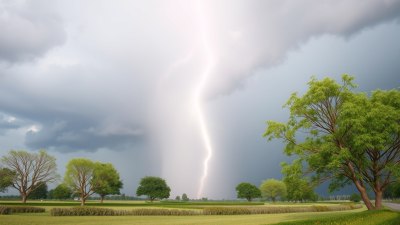The Forecast Said Vibes, But It's Just Static Again
Explore the contrast between hopeful forecasts and disappointing realities through a poetic and insightful narrative.

Weather forecasts often bring a sense of anticipation—a promise of change, of moods transformed by shifting skies and breezes that carry the scent of something new. When the forecast says "vibes," it sets an expectation: something beyond the mundane, a sensory experience charged with emotion and potential. But what happens when that forecast fails to manifest? When the skies deliver static, an unchanging monotony that dulls the senses instead of enlivening them?
"The Forecast Said Vibes, But It's Just Static Again" captures this tension between hopeful anticipation and the often disappointing reality that follows. This paradox is not mere meteorology; it is a metaphor for life's unpredictable rhythms—the hopes we nurture when conditions seem ripe for change, only to find ourselves facing the same stale patterns yet again.
The term "vibes" itself invites a broad palette of meanings. It conveys atmosphere, mood, emotional undercurrents, and interpersonal energies. The weather forecast using this vernacular suggests a wild departure from scientific measurements—a nod to the intangible, to feelings rather than facts. Forecasts traditionally bring numbers, percentages, and technical expectations. Here, though, the forecast becomes poetic, embracing an emotional forecast rather than a meteorological one.
Yet, irony clenches tightly when the forecasted vibes dissipate into static. Static symbolizes noise without signal, interference without clarity—a relentless white noise that camouflages meaning and blocks connection. Rather than waves lapping gently on a shore or musical harmonies floating through the airwaves, static represents a barrier, disruption, and disillusionment.
Experiencing such a disconnect can be jarring. It's like waiting for a sunrise that never bursts forth, sensing potential energy that fails to ignite. It is the space between expectation and experience, where human cognition makes its most profound observations about hope, disappointment, and resilience.
The phrase "just static again" implies repetition, a cycle of failed expectations not once, but multiple times. This repetition colors the emotional landscape with frustration and resignation. When life feels like a series of static-laden forecasts, we learn to read between the lines, to look deeper for meaning amid empty signals.
One way to interpret this metaphor is through the lens of interpersonal relationships. The "vibes" forecasted might represent an anticipated connection, openness, or mutual understanding. Instead, static might suggest miscommunication, emotional barriers, or the reiteration of disconnection. Here, the language of weather becomes a canvas for human interactions—weathering storms, navigating fog, or chasing elusive moments of sunshine amid the clouds.
Moreover, static can also denote a technological failure, drawing attention to how modern life increasingly mediates experience through screens and devices. Where once direct interaction shaped our perceptions, now signals can falter, messages distort, and expectations erode under the pressure of imperfect transmissions. The forecast, in this context, might represent the curated digital outlook we embrace, only to face the noisy interference of reality.
Philosophically, the interplay of forecasted vibes and static recalls the human tension between knowing and not knowing. We desire prediction—certainty about the future, clarity in what lies ahead. But life often denies this desire, offering ambiguity or confusion instead. This tension plays out endlessly in human psychology, culture, and art.
In literature and composition, static has been used as a motif representing isolation, mental unrest, or existential voids. Grounding "The Forecast Said Vibes, But It's Just Static Again" in literary tradition invites us to explore themes of alienation and the search for meaning amid existential noise.
Artists often grapple with these themes by creating contrasts; vibrant colors underscore dull moments, lyrical passages follow cacophonous interruptions. Similarly, musical composers might juxtapose harmonious sections with dissonant static, inviting listeners into emotional complexity.
The forecasted vibes become a promise laid bare against the starkness of static, a promise to be felt but left unfulfilled. This betrayal of expectation poignantly expresses the gap between desires and reality, which many find deeply relatable.
In psychological terms, this dynamic aligns with cognitive dissonance, where beliefs, expectations, or hopes clash with experience. We might anticipate a meaningful connection or a breakthrough moment—the forecasted vibes—but instead face the monotonous drone of unchanging circumstance—the static, again and again.
How then do we cope with such persistent static? Some turn inward, finding solace in reflection, meditation, or acceptance of uncertainty. Others seek external changes, new perspectives, or radical shifts to interrupt the monotony.
Resilience, in this context, is about cultivating patience with weather that refuses to change, nurturing an inner vitality that doesn't depend on outer conditions. It's about appreciating subtle shifts, small variations hidden within the static, the micro-changes that hint at eventual transformation.
Examining societal contexts, "The Forecast Said Vibes, But It's Just Static Again" can be read as commenting on larger cultural or political climates. Promises of progress, innovation, or renewal may be forecasted by leaders or media, but lived experience may reveal stagnation, obstruction, or cyclical setbacks. The static in this landscape symbolizes systemic barriers and the frustration of unfulfilled potential.
Historically, periods of revolutionary optimism sometimes dissolve into disillusionment when change unfolds slower or differently than imagined. The metaphor thus becomes a tool for cultural critique, reflecting collective moods and the tension between hope and reality shared across communities and nations.
At its heart, this phrase is a meditation on the interplay of hope, expectation, and experience. It highlights how meaning is dynamically constructed—not only by the events themselves but through our responses and interpretations.
Perhaps the most striking aspect is the ongoing hope embedded in the phrase. Despite repeated disappointments—the static again and again—the reference to forecasted vibes implies an enduring belief in possibility, a persistent invitation to feel, sense, and anticipate.
This dynamic tension fuels creative expression and human endeavor—the anticipation of a different tomorrow even when today's signal is clouded or unheard.
In practical terms, recognizing when a forecast promises vibes but delivers static is a call to mindfulness. It invites one to recalibrate expectations, to listen for subtle signals beneath the noise, and to engage with the present realities while remaining open to change.
In art and media, the phrase evokes strong imagery of radio waves buzzing with interference, television screens flickering with white noise, or static feedback in sound systems. These sensory images underscore the theme of communication challenges—the desire to transmit meaning faced with distortion and disconnection.
Exploring the etymology, static originates from the Greek "statikos," meaning causing to stand or stationary. This root meaning lends itself well to the metaphorical use—standing still, halted movement, unmoving energy. The forecast promising vibes signifies movement, flow, dynamism, yet static resists, grounds, and stills.
The contrast between movement and stillness intersects with broader philosophical debates about change and permanence. Heraclitus famously stated "No man ever steps in the same river twice," championing constant flux, while Parmenides extolled being and unchanging reality. Static, in this metaphor, embodies the unchanging, the obstinate refusal of flux forecasted but unrealized.
This interplay mirrors human emotional experiences: moments where life surges forward, generating sensations and excitement, contrasted with times of emotional numbness or stasis where little seems to happen.
In psychological wellness, acknowledging static moments without despair becomes crucial. These are times when growth is less visible, when feelings lie dormant, preparing for future waves—a necessary, albeit frustrating, part of any cycle.
Future-looking interpretations might consider how embracing both vibes and static leads to a balanced perspective, one that accepts potential alongside patience with the slow unfolding of time.
In this, the forecast becomes less a prediction and more a framework for understanding emotional and experiential variability—sometimes vibrant, sometimes muted, always part of a larger pattern.
Technology too is engaged in this dialogue with static. The analogy extends to the challenges of communication in digital realms—glitches, dropped calls, buffering screens—where forecasts of seamless connectivity are often disrupted by static, reminding us of imperfection inherent in mediated experience.
Artists have long found inspiration in static noise—the randomness of white noise as a canvas for improvisation, experimentation, and innovation. In music, genres like noise music or glitch embrace static's textures, transforming interference into art. This reframing challenges notions of failure and embraces disruption as creative energy.
Layering that back onto our phrase, the forecast of vibes juxtaposed with static beckons a deeper appreciation of how disruption itself might be fertile ground—not just barren space.
Personally, readers might reflect on moments in their lives when waking to hopeful mornings led to stagnant days. What did they learn through those static periods? How did they discover subtle textures beneath the surface? How did they reinterpret the forecast to sustain meaning?
This meditation encourages active engagement with life's unpredictability and complexity, underscoring that static is not inherently negative but a vital aspect of the human condition.
In mental health, this recognition is pivotal. Rather than pathologizing periods of emotional quiet or flatness, one can understand such phases as integral to holistic wellness, recovery, and balance.
The forecast thus becomes less about predicting highs and lows and more about accepting a spectrum of experience, honoring the full range of life's emotional frequencies.
On a communal level, shared experiences of forecasted vibes and consequent static offer opportunities for empathy and connection. When people relate to this common frustration, it fosters understanding and solidarity—a collective 'we are in this' amid the noise.
This collective recognition can inspire mutual support, patience, and creativity in facing life's unresolved cacophonies together.
In sum, "The Forecast Said Vibes, But It's Just Static Again" resonates far beyond its simple words. It acts as a poetic allegory for human hopes, the complexities of communication, and the cycles of anticipation and disappointment inherent in lived experience.
This phrase invites reflection on how meaning is shaped by our interpretations and responses to the unpredictable flow of life's signals—whether clear or muffled by static—and encourages embracing ambiguity with curiosity rather than despair.
Ultimately, it illuminates the paradox of forecasting a future filled with vibrant emotions ('vibes'), only to confront moments of static interruption—moments that test our resilience and our capacity to find value in both movement and stillness.
Such reflection opens paths toward greater self-awareness, artistic insight, social empathy, and philosophical acceptance, inviting us to listen carefully to all the signals life sends, the harmonious and the chaotic alike.











